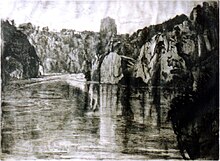Hermann Lechner (painter)
Franz Hermann Lechner (born October 17, 1879 in Würzburg , † January 21, 1924 in Hittenkirchen ) was a German painter and etcher .
Life
Franz Hermann Lechner was the third child of Margarethe Lechner (1847–1926) and the cutlery Franz Joseph Alexander Geiß (1851–1881). He lost his father at the age of two. The mother earned the living for him and his two older sisters, Elisa (* 1873) and Theodora (* 1876), as a seamstress . After attending elementary school , he began an apprenticeship as a stonemason and attended the Würzburg drawing and modeling school . From there he soon went to the School of Applied Arts in Nuremberg in the circle of Rudolf Schiestl (1878–1931) and Hans Huber-Sulzemoos (1873–1951). At the age of twenty he moved to Munich, where he enrolled on May 14, 1900 at the Munich Art Academy in the class of Martin von Feuerstein (1856–1931). He later became a student of Peter Halm (1854–1931) and Hermann Groeber (1865–1935), with whom he was on friendly terms throughout his life. In August 1914, Lechner married Susanne Christ, the daughter of the university professor Wilhelm von Christ, and moved to a secluded farmhouse on the Dandlberg, in the municipality of Samerberg above the Inn Valley . There he belonged to the circle of Samerberg artists and was friends with Karl Hermann Müller-Samerberg , who lived in Törwang and united a group of young painters around him. In the following years, the children Anna Notburga (* 1915), Wilhelm Tilman (* 1916) and Friedrich Peter (* 1917) were born on the Dandlberg. After the artist was called up for military service , his wife and her children were largely left to fend for themselves. In 1921 the family moved to Hittenkirchen near Prien am Chiemsee , where his friend and teacher Hermann Groeber gathered the Frauenwörther painters' colony around him. With the help of Susanne Lechner's brother, they were able to buy a house there. The son Viktor was born here in 1922. In Hittenkirchen, Lechner maintained contact with the Prien artists' association Die Welle , in whose exhibition he only participated as a guest in 1922, probably due to lack of financial means for membership. Lechner died of blood poisoning on January 21, 1924 at the age of only 45 . In the same year the Münchner Kunstverein organized a memorial exhibition for the artist.
plant
Lechner painted landscapes from the Inn Valley and the Maingau , as well as portraits . The Münchner Kunstverein paid tribute to Franz Hermann Lechner with the following words: “What bitter, honest, convincing, completely independent art he had to offer was only revealed by the estate exhibition of his works (...) Hermann Lechner died (...) before he saw the success of his Years of fighting could have reaped. ”As can be seen from Lechner's letters to his future wife, the young artist hoped to create a solid livelihood through the craft of etching. From the years before 1914 there are some topographically very precisely executed etchings with views of a journey that took him from Kronach Castle to Kelheim . In Kelheim in the autumn of 1913 he worked on a series of etchings that he was preparing for the celebration of the hundredth anniversary of the wars of liberation . Two exhibitions with his etchings took place in August 1913 in the rooms of the Würzburger Landeszeitung and in the local art dealer Scheuner. The personal significance of the Kelheim etchings for Lechner is also evident in the fact that he handed them over to “His Majesty the King and Emperor in Berlin” as well as to the Prince Regent of Bavaria, from whom, according to his letters, he received a letter of thanks.
Exhibitions
- 1924: Estate exhibition at the Munich Art Association
- 1925: Guest exhibitor of the artists' association Die Welle in Prien / Chiemsee
literature
- Thieme-Becker : Lechner, Hermann . In: General Artist Lexicon . The visual artists of all times and peoples (AKL). Volume 22, Saur, Munich a. a. 1999, ISBN 3-598-22762-0 , p. 518.
Individual evidence
- ^ Franz Hermann Lechner on the website artroots.com .
- ↑ See Thieme-Becker, Volume 22, 1928, p. 518.
- ↑ Kunstverein München eV statement of accounts , 1924, p. 18.
| personal data | |
|---|---|
| SURNAME | Lechner, Hermann |
| ALTERNATIVE NAMES | Lechner, Franz Hermann (full name) |
| BRIEF DESCRIPTION | German painter and etcher |
| DATE OF BIRTH | October 17, 1879 |
| PLACE OF BIRTH | Wurzburg |
| DATE OF DEATH | January 21, 1924 |
| Place of death | Hittenkirchen |


